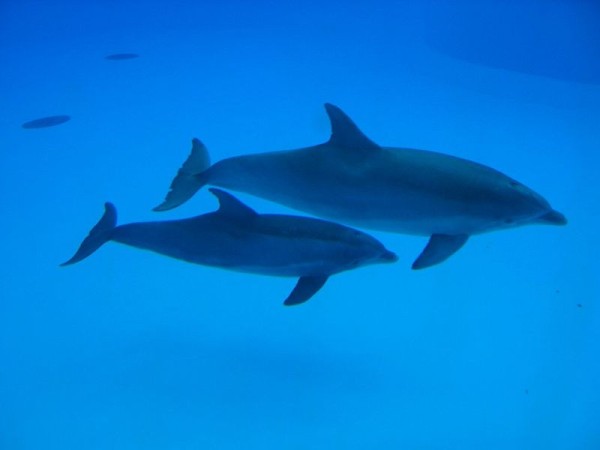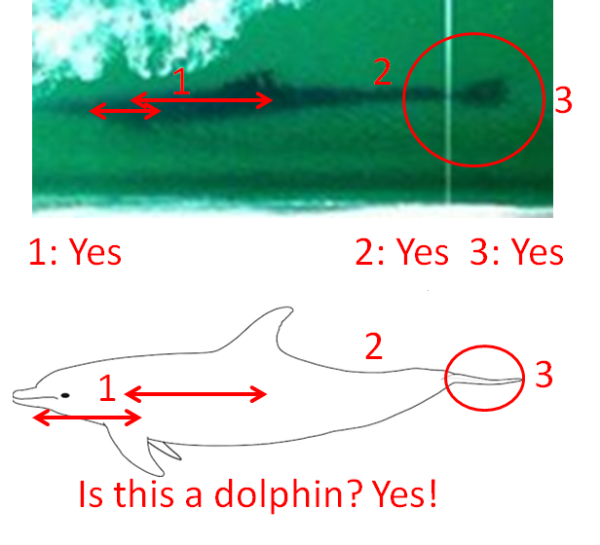Editor’s Note: This article originally occurred at Southern Fried Science and is republished here with permission. The post is authored by shark expert and graduate student at the University of Miami David Shiffman.
When California resident June Emerson snapped a photo of her children playing at the beach, she didn’t expect it to generate international news. Although the kids seem to be adorable, that isn’t what captured the attention of the media. In a wave behind them, you can see the outline of a large animal swimming by (or being “terrifying” and “creeping up on them,” as the Daily Mail called it).

The media, including local, national, and international outlets, wasted no time in calling it a shark. However, as Jason Goldman wryly noted, “not all grey things with dorsal fins in the ocean are sharks.” This animal is almost certainly a dolphin. I asked a dozen shark scientists and a handful of dolphin scientists, and all quickly agreed that this is a dolphin.
As I’m no fan of merely appealing to authority (though I’ll trust someone with years of training over the painful to read comments on many of the news pieces), I’ll share with you how we can tell. First, let’s clean up and brighten the image. Since I am not a photoshop master, let’s borrow a cleaned up and enhanced image from KTLA.

Even though the image is somewhat blurry (understandable, as June was trying to photograph her children and not the animal behind them,) there are still easily identifiable features that clearly show that this is not a great white shark, but a dolphin.
Lets compare the rough outline of a great white shark with that of adolphin (images are from Wikipedia, H/T to Pete Thomas for finding them and pointing them out to me).
On a great white shark, the pectoral fins are relatively far from the head and relatively close to the first dorsal fin (#1) . Like all sharks, great whites have a second dorsal fin (#2). Like all sharks, great whites swim by moving their tail side-to-side (#3).

Though I used a side-view drawing for convenience, these features are all easily seen on the real thing.

On a dolphin, pectoral fins are relatively close to the head and relatively far from the dorsal fin (#1). There is no second dorsal fin (#2). Unlike sharks, dolphins swim by moving their tails up and down, resulting in a drastically different tail shape (#3).
 Again, these features are all easily seen on the real animal.
Again, these features are all easily seen on the real animal.

So, now that you know what to look for, let’s compare June’s image with the features of a great white shark.
 Now let’s compare June’s photo with that the features of a dolphin.
Now let’s compare June’s photo with that the features of a dolphin.
In a pseudo “debate” with me (we never actually communicated directly) for CNN, Shark Week producer Jeff Kurr noted that there have been a lot of juvenile great whites in this area. That’s absolutely true, and it’s a good sign for the conservation of the species. However, that’s hardly evidence that this is a great white. He didn’t note that there are also a lot of dolphins in the area, and that they’re often observed surfing in the waves.
The cynic in me can’t help but notice that many news articles noted within the text of the article that this could easily be a dolphin, yet hardly any used “dolphin” in their headline. It isn’t hard to imagine an editorial discussion along the lines of “eh, it may be a shark, it may be a dolphin, more people will click the link if it talks about a big scary shark near cute innocent children.” Though not exactly rare, this kind of fear-mongering “if it bleeds, it leads” journalism has had a significant negative impact on public perception of sharks, and by extension shark conservation policy, and by extension the population status of threatened species.
June and her children were in no danger, which also would have been true if the animal photo-bombing them was a juvenile great white shark. Many species of sharks are in danger, and sensationalist journalism such as much of the coverage of this “photobomb” does them no favors.
Share the post "Here’s how you can tell that the “shark” photobombing kids is actually a dolphin"







A producer of Shark Week says it’s a shark? That’s all the evidence you really need that it’s a dolphin. We know how far we can trust those guys.
Wonder if anyone took into account the water and curl of the wave when looking at the photo? Both will distort the real shape and size of whatever it really is in the water.
Huh? You think refraction is going to make a shark look like a dolphin?
Refraction will not make the pectoral fins appear near the head of a shark. It is a dolphin.
Im guessing you have not studied the physics of light.
Great analysis – but there is a problem that goes back to the original photo, as touched on by Dobbs in an above comment. If you take the photo, stretch it vertically to approximately correct for the distortion caused by the water, three things become apparent.
Firstly, the tail becomes much taller, and is certainly closer to the shark profile than the dolphin profile.
Secondly, there is a hump just in front of the tail where the 2nd dorsal fin should be for a shark (its a small hump but the fin is small too).
Thirdly, What is being described as the pectoral fin is actually one of three distinct dark bands descending down from the body of the shark. The other two bands are closer to the dorsal fin. Clearly the animal can not have 3 fins here – but the point is the identification of the first band has to be in doubt.
Anyone can see what I have described by screen grabbing the photo, pasting in to paint, dragging a select box over the photo, and resizing vertically about 2 x. It takes 1 minute. Check it before saying I’m crazy!
Cheers, thanks for posting this!
Checked, and sadly still think you’re crazy.
No matter how you stretch it the tail still won’t look like a dolphins tail. Look at the drawings of each. The dolphins tail is straight across from tip to tip. The great white’s tail has a VERY pronounced V shape to it. Also, if you look at the picture of the dolphin’s tail you will notice that they also have a noticeable hump just before the tail.
Another point is that if you look at the dorsal fin (in the pic with the kids) the dorsal fin is noticeably “back swept” at the top, as are the dolphins, unlike the great white’s which is more triangular.